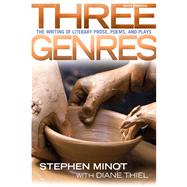
About Stephen Minot
Stephen Minot, Professor Emeritus of the Creative Writing Department at the University of California, Riverside, has taught creative writing for over thirty years. Over the span of his very successful career, Professor Minot authored three novels, two collections of short stories, and three textbooks including Reading Fiction and Literary Nonfiction, The Fourth Genre. His short stories have appeared in a variety of magazines and literary quarterlies including The Atlantic, Harpers, The Kenyon Review, The Virginia Quarterly Review, and the Sewanee Review, just to name a few. Professor Minot’s work has also appeared in the O. Henry Prize Stories collection and The Best American Short Stories. He is also the recipient of the Atlantic First Award, the Saxton Memorial Fellowship, and the National Endowment for the Arts Fellowship for writing. Professor Minot and Virginia, his wife, split their time between California and Maine.
About Diane Thiel
Diane Thiel is the author of eight books of poetry, nonfiction and creative writing pedagogy, including Echolocations, Resistance Fantasies, Winding Roads: Exercises in Writing Creative Nonfiction, Cross Roads: Creative Writing in Four Genres, and Open Roads: Exercises in Writing Poetry. Thiel’s translation of Alexis Stamatis’s novel, American Fugue, received an NEA Award. Her work appears in many journals, is re-printed in over fifty anthologies, and has been translated widely. She has received numerous awards, such as the PEN Translation, Robert Frost, and Robinson Jeffers Awards, and was a Fulbright Scholar. Thiel has taught creative writing for twenty years and is a Professor at the University of New Mexico.
CONTENTS
Preface for Students
Preface for Teachers
Part I: TELLING A STORY: LITERARY NONFICTION AND FICTION
A. Literary Nonfiction
1. Literary Nonfiction: An Overview
2. True Experience
3. Nonfiction in a Reflective Mood
4. Impressions of a Real Place
5. “Westbury Court”: Literary Nonfiction by Edwidge Danticat
6. Creating Your Own Literary Nonfiction
B. Fiction
7. Fiction: The Freedom to Invent
8. Finding and Shaping Fresh Material
9. “Escapes”: A Story by Ann Hood
10. Viewpoint: Who’s Seeing This?
11. “Rwanda”: A Story by Stephen Minot
12. The Making of a Story
13. Structure: From Scenes to Plot
14. “A Simple Matter of Hunger”: A Story by Sharon Oard Warner
15. Creating Tension
16. Setting: Where am I?
17. “Obst Vw” A Story by Sharon Solwitz
18. Dialogue: The Illusion of Speech
19. Characterization: Creating Credible People
20. Liberating the Imagination
21. Three Flashes of Fiction:
“The Bank Robbery”: A Story by Steven Schutzman
“Stockings”: A Story by Tim O’Brien
“Girl”: A Story by Jamaica Kincaid
22. Heightened Meaning: Metaphor, Symbol, and Theme
23. “Gotta Dance”: A Story by Jackson Jodie Daviss
24. Style and Tone
25. Five Ways to Open Up a Story
26. Troubleshooting Guide: Fiction
PART II: THE WRITING OF POETRY
27. What Makes a Poem a Poem?
28. Plunging In: A Selection of Poems
Robert Frost, “Design”
John Updike, “Winter Ocean”
William Stafford, “Traveling through the Dark”
Carol Oles, “The Gift”
Molly Peacock, “Anger Sweetened”
William Shakespeare, “Sonnet 29”
Lucille Clifton, “What the Mirror Said”
Chora, “After Spring”
Etheridge Knight, “Haiku”
Clement Long, “Always the One Who Loves His Father Most”
Maya Angelou, “This Winter Day”
Barbara Howes, “ The Bay at West Falmouth”
Robley Wilson, “On a Maine Beach”
James Bertram, “Is it Well-Lighted, Papa?”
Theodore Roethke, “The Waking”
Philip Appleman, “Coast to Coast”
E.E. Cummings, “Buffalo Bill’s”
Maxine Kumin, “Morning Swim”
Rhina Espaillat, “Bilingual/Bilingüe”
Craig Raine, “A Martian Sends a Postcard Home”
Richard Wilbur, “The Pardon”
Nikki Giovanni, “Balances”
Chase Twichell, “Rhymes for Old Age”
Donald Hall, “Names of Horses”
Joy Harjo, “She Had Some Horses”
Naomi Shihab Nye, “Famous”
Stephen Dunn, “A Secret Life”
Dorothy Barresi, “Mystery”
Theodore Deppe, “The Paradise of Wings”
Thomas McGrath, “Nuclear Winter”
Anita Endrezze, “The Mapmaker’s Daughter”
29. Sources: Where Poems Come From
30. The Impact of Images
31. Using the Sound of Language
32. Traditional Rhythms
33. Stanzas: a Choice of Fixed Forms
34. Free Verse: Creating Unique Forms
35. A Sense of Order
36. Varieties of Tone
37. Finding the Form: A Revision Narrative with Exercises
Diane Thiel, “Memento Mori in Middle School”
38. Poems for Self-study
Paula Gunn Allen, “Grandmother”
Joseph Bruchac, “Indian Country Again”
Christopher Buckley, “Intransitive”
Andrea Hollander Budy, “Burning the Letters”
David Curry, “To Those Who Are Programming Computers to Produce Poetry”
Jim Daniels, “Short-order Cook”
Dana Gioia, “California Hills in August”
R.S. Gwynn, “Shakespearean Sonnet”
Judy Kronenfield, “Maiden Voyages”
April Linder, “Dog Bite”
Rita Marie Martinez, “Going Bananas”
Edna St. Vincent Millay, “What Lips My Lips Have Kissed”
Maurya Simon, “The Afterlife”
Pireeni Sundara lingham, “Lot’s Wives”
Jenniver Tseng, “Autobiography of an Immigrant”
Carolyn Beard Whitlow, “Rockin’ a Man Stone Blind”
David Young, “Love Song for Chloe”
39. Troubleshooting Guide: Poetry
PART III: THE WRITING OF DRAMA
40. Drama: A Live Performance
41. A Play by William Saroyan: “Hello Out There”
42. The Dramatic Plot
43. A Play by Tony Padilla: “Reckoning”
44. Conflict: Emotional Impact
45. A Play by Glenn Alterman, “Coulda, Woulda, Shoulda”
46. The Nonrealistic Play
47. Dramatic Characterization
48. Visual Impact
49. The Voices of Comedy
50. Dramatic Themes
51. Five Dramatic Exercises
52. Troubleshooting Guide: Drama
APPENDICES
A. Submitting Work for Publication
B. Resources for Writers
CREDITS
INDEX OF AUTHORS AND TITLES
GLOSSARY-INDEX
The New copy of this book will include any supplemental materials advertised. Please check the title of the book to determine if it should include any access cards, study guides, lab manuals, CDs, etc.
The Used, Rental and eBook copies of this book are not guaranteed to include any supplemental materials. Typically, only the book itself is included. This is true even if the title states it includes any access cards, study guides, lab manuals, CDs, etc.